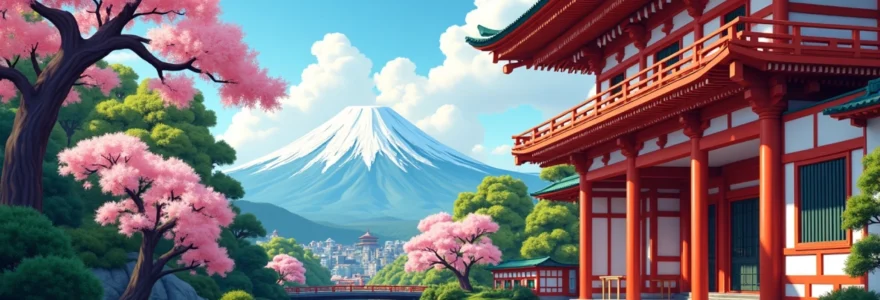Tokyo, a city where ancient traditions seamlessly intertwine with cutting-edge modernity, offers an unparalleled tapestry of leisure activities. This bustling metropolis captivates visitors with its unique blend of historic charm and futuristic allure, providing a diverse range of experiences that cater to all tastes and interests. From the tranquil beauty of centuries-old gardens to the neon-lit streets of entertainment districts, Tokyo’s leisure landscape is a testament to Japan’s remarkable ability to honour its past while embracing innovation.
Traditional leisure activities in tokyo’s historic districts
Delving into Tokyo’s historic districts unveils a world where time-honoured traditions continue to thrive amidst the city’s rapid modernisation. These areas offer visitors a chance to immerse themselves in authentic Japanese culture, providing a stark contrast to the frenetic pace of urban life.
Kabuki theatre at kabukiza in ginza: performances and etiquette
The Kabukiza Theatre in Ginza stands as a beacon of traditional Japanese performing arts. This iconic venue, with its distinctive architecture, hosts daily performances of Kabuki, a classical form of Japanese dance-drama known for its stylised performances and elaborate costumes. Attending a Kabuki performance is not merely a spectacle but a cultural education, offering insights into Japan’s rich theatrical heritage.
When attending a Kabuki performance, it’s essential to observe proper etiquette. Silence during the performance is paramount, and photography is strictly prohibited. Many theatregoers opt for single-act tickets, allowing them to experience a portion of a longer performance. For those unfamiliar with Japanese, English audio guides are available, providing valuable context and explanations throughout the show.
Kabuki theatre is a living embodiment of Japan’s artistic legacy, where every gesture and expression carries centuries of tradition.
Tea ceremonies in happo-en gardens: rituals and significance
The Happo-en Gardens offer a serene escape from Tokyo’s urban sprawl, providing an ideal setting for experiencing the timeless ritual of the Japanese tea ceremony. This meticulously landscaped garden, complete with a tea house, allows visitors to partake in this centuries-old practice that embodies the principles of harmony, respect, purity, and tranquillity.
During a tea ceremony, every movement is deliberate and meaningful. Guests are guided through the process of receiving and consuming matcha , a finely ground green tea. The ceremony’s significance extends beyond the mere act of drinking tea; it’s a meditative practice that encourages mindfulness and appreciation for the present moment.
Sumo wrestling at ryogoku kokugikan: tournaments and traditions
The Ryogoku Kokugikan, Tokyo’s premier sumo stadium, offers visitors the chance to witness Japan’s national sport in all its glory. Sumo wrestling, with its rich history dating back over 1,500 years, is more than just a sport; it’s a cultural institution steeped in ritual and tradition.
Tournaments, known as basho , are held six times a year, with three taking place in Tokyo. Attending a tournament provides a unique opportunity to experience the pageantry and excitement of this ancient sport. From the elaborate entrance ceremonies to the lightning-fast bouts, sumo offers a glimpse into a world where strength, strategy, and spirituality converge.
Modern entertainment hubs in tokyo’s urban landscape
While Tokyo honours its traditions, it simultaneously embraces the future with unparalleled enthusiasm. The city’s modern entertainment districts showcase Japan’s innovative spirit, offering visitors a glimpse into the cutting edge of technology, pop culture, and nightlife.
Akihabara’s electronics and anime culture: shops and experiences
Akihabara, often referred to as “Electric Town,” is a paradise for technology enthusiasts and anime aficionados alike. This vibrant district is home to countless electronics stores, ranging from multi-story tech emporiums to small shops specialising in niche gadgets. Here, visitors can find the latest technological innovations, often months before they’re available in other parts of the world.
Beyond electronics, Akihabara is the epicentre of Japan’s anime and manga culture. The streets are lined with shops selling merchandise, collectibles, and rare editions of popular series. Maid cafes , a unique Japanese phenomenon, offer visitors a quirky dining experience where waitresses dressed as anime characters serve food and perform songs.
Shibuya’s nightlife scene: clubs, bars, and the famous crossing
Shibuya is synonymous with Tokyo’s vibrant youth culture and pulsating nightlife. At its heart lies the iconic Shibuya Crossing, often described as the world’s busiest pedestrian intersection. This sea of humanity, with its massive video screens and neon signs, epitomises the energy and excitement of modern Tokyo.
As night falls, Shibuya transforms into a playground for night owls. The district boasts an eclectic mix of venues, from high-energy nightclubs playing the latest electronic music to intimate jazz bars tucked away in narrow alleys. For those seeking a unique experience, karaoke boxes offer private rooms where friends can sing their hearts out well into the early hours.
Odaiba’s futuristic attractions: TeamLab borderless and joypolis
Odaiba, a man-made island in Tokyo Bay, is a showcase of futuristic architecture and cutting-edge entertainment. The district is home to TeamLab Borderless, a groundbreaking digital art museum that blurs the lines between technology and creativity. This immersive experience features ever-changing installations that respond to visitors’ movements, creating a truly interactive artistic journey.
For thrill-seekers, Joypolis offers a high-tech amusement park experience. This indoor facility features virtual reality rides, 3D games, and interactive attractions that push the boundaries of entertainment technology. Odaiba exemplifies Tokyo’s commitment to innovation, providing visitors with a glimpse into the future of leisure and entertainment.
Fusion of old and new in tokyo’s leisure offerings
Tokyo’s ability to seamlessly blend traditional elements with modern innovations is perhaps most evident in areas where the old and new coexist in harmony. These districts offer a unique perspective on how Japan navigates the delicate balance between preserving its cultural heritage and embracing contemporary trends.
Harajuku’s street fashion: takeshita street and omotesando hills
Harajuku is the beating heart of Tokyo’s youth fashion scene, where avant-garde styles and traditional attire create a vibrant tapestry of self-expression. Takeshita Street, a narrow pedestrian thoroughfare, is lined with boutiques, vintage shops, and quirky cafes catering to the latest street fashion trends. Here, visitors can witness the ever-evolving world of Japanese youth culture, from cosplay enthusiasts to avant-garde fashionistas.
In stark contrast, nearby Omotesando Hills offers a more upscale shopping experience. This tree-lined avenue is home to flagship stores of international luxury brands, seamlessly integrating modern architecture with the area’s natural beauty. The juxtaposition of Takeshita Street’s youthful energy and Omotesando’s refined elegance perfectly encapsulates Tokyo’s diverse fashion landscape.
Harajuku is where tradition meets rebellion, creating a kaleidoscope of styles that continually redefines fashion norms.
Asakusa’s blend of temple tourism and modern shopping
Asakusa offers visitors a unique opportunity to step back in time while enjoying modern conveniences. The district is home to Senso-ji, Tokyo’s oldest Buddhist temple, which draws millions of visitors each year. The approach to the temple, known as Nakamise, is a centuries-old shopping street lined with traditional crafts, snacks, and souvenirs.
Yet, just steps away from these historic sites, visitors can find contemporary shopping centres and dining establishments. This harmonious coexistence of old and new allows tourists to experience the best of both worlds, from traditional wagashi (Japanese sweets) to modern interpretations of classic dishes in trendy cafes.
Roppongi’s art scene: traditional galleries to contemporary museums
Roppongi, once primarily known for its nightlife, has transformed into a hub for art and culture. The district now boasts a diverse array of museums and galleries that cater to all artistic tastes. The Mori Art Museum, located atop the Roppongi Hills complex, offers breathtaking views of the city alongside cutting-edge contemporary art exhibitions.
For those interested in traditional Japanese art, the Suntory Museum of Art houses an impressive collection of ceramics, lacquerware, and textiles. The National Art Center, Tokyo, with its undulating glass facade, hosts temporary exhibitions spanning various periods and styles, further cementing Roppongi’s status as a multifaceted art destination.
Natural escapes within tokyo’s metropolitan area
Despite its reputation as a concrete jungle, Tokyo offers numerous green spaces where residents and visitors alike can reconnect with nature. These urban oases provide a welcome respite from the city’s frenetic pace, offering opportunities for relaxation, reflection, and outdoor activities.
Ueno park: cherry blossoms, museums, and zoo attractions
Ueno Park stands as one of Tokyo’s most beloved public spaces, attracting millions of visitors annually. During spring, the park transforms into a pink wonderland as thousands of cherry trees burst into bloom, making it one of the city’s most popular hanami (cherry blossom viewing) spots.
Beyond its natural beauty, Ueno Park is home to several world-class museums, including the Tokyo National Museum and the National Museum of Western Art. The Ueno Zoo, Japan’s oldest zoological garden, offers visitors a chance to observe a wide variety of animals, including giant pandas, in thoughtfully designed habitats.
Meiji shrine’s forested grounds: spiritual walks and wedding observations
Nestled in the heart of Tokyo, Meiji Shrine and its surrounding forest provide a serene escape from urban life. This Shinto shrine, dedicated to Emperor Meiji and Empress Shoken, is set within a 70-hectare evergreen forest, creating a peaceful sanctuary in the midst of the bustling city.
Visitors can partake in traditional Shinto rituals, such as writing wishes on ema (wooden plaques) or participating in a guided meditation walk through the forest. On weekends, it’s not uncommon to witness traditional Japanese wedding processions, offering a glimpse into the country’s enduring cultural practices.
Mount takao: hiking trails and buddhist temple exploration
For those seeking a more challenging outdoor experience, Mount Takao offers an accessible day trip from central Tokyo. This 599-meter peak features a network of hiking trails suitable for various fitness levels, from gentle walks to more strenuous climbs.
The mountain is also home to Yakuo-in, an ancient Buddhist temple complex founded in 744 CE. Visitors can explore the temple grounds, participate in meditation sessions, or witness goma fire rituals performed by resident monks. The summit provides panoramic views of Tokyo and, on clear days, even Mount Fuji, serving as a reminder of Japan’s natural beauty.
Culinary adventures: tokyo’s gastronomic landscape
Tokyo’s culinary scene is a reflection of its broader cultural landscape, offering a delightful mix of traditional flavours and innovative gastronomy. From bustling markets to Michelin-starred restaurants, the city provides endless opportunities for food enthusiasts to explore Japan’s rich culinary heritage and its modern interpretations.
Tsukiji outer market: traditional fish auctions and sushi breakfasts
While the famous tuna auctions have moved to Toyosu Market, the Tsukiji Outer Market remains a vibrant hub of culinary activity. This labyrinth of narrow alleys is lined with vendors selling fresh seafood, produce, and kitchen equipment. Early risers can witness the frenetic energy of the market coming to life and indulge in a sushi breakfast at one of the many restaurants in the area.
For those interested in Japanese culinary traditions, the market offers opportunities to purchase specialty ingredients and unique kitchen tools. Guided tours are available for visitors looking to gain deeper insights into the market’s history and the intricacies of Japanese cuisine.
Michelin-starred experiences: from sukiyabashi jiro to narisawa
Tokyo boasts more Michelin-starred restaurants than any other city in the world, offering discerning diners unparalleled culinary experiences. Sukiyabashi Jiro, made famous by the documentary “Jiro Dreams of Sushi,” represents the pinnacle of traditional sushi craftsmanship. Reservations at this three-star establishment are notoriously difficult to secure, but the experience is considered by many to be the ultimate expression of omakase dining.
On the innovative end of the spectrum, restaurants like Narisawa blend Japanese ingredients with avant-garde techniques, creating dishes that are as visually stunning as they are delicious. These establishments showcase the evolution of Japanese cuisine, demonstrating how chefs are pushing boundaries while respecting traditional flavours and techniques.
Street food culture: yatai stalls in yurakucho and shinjuku
For a more casual dining experience, Tokyo’s street food scene offers a wealth of delicious options. Yurakucho, with its network of yakitori (grilled chicken skewer) stalls nestled under the train tracks, provides an atmospheric setting to enjoy this classic Japanese snack alongside a cold beer.
In Shinjuku, the narrow alleys of Omoide Yokocho (Memory Lane) are lined with tiny yatai stalls serving grilled meat, oden (simmered dishes), and other traditional fare. These bustling areas offer not just delicious food but also a glimpse into Tokyo’s vibrant after-work culture, where locals and tourists alike gather to unwind and socialise over shared plates and drinks.
Tokyo’s leisure landscape is a testament to the city’s ability to honour its past while embracing the future. From the tranquil gardens of Happo-en to the futuristic digital art of TeamLab Borderless, visitors can experience the full spectrum of Japanese culture and innovation. Whether indulging in a traditional tea ceremony, exploring cutting-edge technology in Akihabara, or savoring world-class cuisine, Tokyo offers an unparalleled mix of experiences that cater to every interest and taste. This dynamic metropolis continues to evolve, ensuring that each visit reveals new facets of its endlessly fascinating character.


